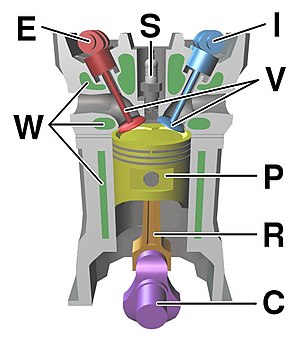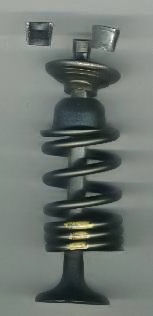Difference between revisions of "Poppet valve"
m |
m |
||
| Line 29: | Line 29: | ||
{{Automobile configurations}} | {{Automobile configurations}} | ||
| + | {{Piston engine configurations}} | ||
| + | {{Machine configurations|state=uncollapsed}} | ||
[[Category:Engine valves]] | [[Category:Engine valves]] | ||
[[Category:Engine technology]] | [[Category:Engine technology]] | ||
Revision as of 12:23, 15 July 2008
A poppet valve is a valve consisting of a hole, usually round or oval, and a tapered plug, usually a disk shape on the end of a shaft also called a valve stem. The shaft guides the plug portion by sliding through a valve guide. In most applications a pressure differential helps to seal the valve and in some applications also open it.
Presta and Schrader valves used on tires are examples of poppet valves. The Presta valve has no spring and relies on a pressure differential for opening and closing while being inflated.
Poppet valves are used in many industrial process from controlling the flow of rocket fuel to controlling the flow of milk.
Internal combustion engine

Poppet valves are used in most piston engines to open and close the intake and exhaust ports in the cylinder head. The valve is usually a flat disk of metal with a long rod known as the valve stem out one end. The stem is used to push down on the valve and open it, with a spring generally used to close it when the stem is not being pushed on. Desmodromic valves are closed by positive mechanical action instead of by a spring, and are used in some high speed motorcycle and auto racing engines, eliminating 'valve float' at high RPM.
For certain applications the valve stem and disk are made of different steel alloys, or the valve stems may be hollow and filled with sodium to improve heat transport and transfer.
The engine normally operates the valves by pushing on the stems with cams and cam followers. The shape and position of the cam determines the valve lift and when and how quickly (or slowly) the valve is opened. The cams are normally placed on a fixed camshaft which is then geared to the crankshaft, running at half crankshaft speed in a four-stroke engine. On high performance engines e.g. used in Ferrari cars, the camshaft is moveable and the cams have a varying height, so by axially moving the camshaft in relation with the engine RPM, also the valve lift varies. See variable valve timing.
Valve position
In very early engine designs the valves were 'upside down' in the block, parallel to the cylinders - the so called L-head engine because of the shape of the cylinder and combustion chamber, also called 'flathead engine' as the top of the cylinder head is flat. Although this design makes for simplified and cheap construction, it has two major drawbacks; the tortuous path followed by the intake charge limits air flow and effectively prevents speeds greater than 2,000-2,500 RPM, and the travels of the exhaust through the block lead to excessive overheating under sustained heavy load. This design therefore evolved into 'Intake Over Exhaust', IOE or F-head, where the intake valve was in the block and the exhaust valve was in the head; later both valves moved to the head.
In most such designs the camshaft remained relatively near the crankshaft and the valves were operated through pushrods and rocker arms. This led to significant energy losses in the engine, but was simpler, especially in a V engine where one camshaft can actuate the valves for both cylinder banks; for this reason, pushrod engine designs persisted longer in these configurations than others.
More modern designs have the camshaft on top of the cylinder head, pushing directly on the valve stem (again through cam followers), a system known as overhead camshaft; if there is just one camshaft, this is a single overhead cam or SOHC engine. Often there are two camshafts, one for the intake and one for exhaust valves, creating the dual overhead cam, or DOHC. The camshaft is driven by the crankshaft - through gears, a chain or in modern engines with a rubber belt.
Valve wear
In the early days of engine building, the poppet valve was a major problem. Metallurgy was not what it is today, the rapid opening and closing of the valves against the cylinder heads led to rapid wear. They would need to be re-ground every two years or so, in an expensive and time consuming process known as a valve job. Adding tetra-ethyl lead to the petrol reduced this problem to some degree as the lead would coat the valve seats, hardening the metal. Valve seats made of improved alloys such as stellite have generally made this problem disappear completely and making leaded fuel unnecessary.
See also
| Piston engine configurations | |
|---|---|
| Straight | Single, 2, 3, 4, 5, 6, 8, 9, 10, 12, 14 |
| V | 2, 4, 5, 6, 8, 10, 12, 16, 20, 24 |
| Flat | 2, 4, 6, 8, 10, 12, 16, H |
| W | 8, 9, 12, 16, 18 |
| Other inline | H, VR, Opposed, U (Square), X |
| Other | Hemi, Radial, Rotary, Pistonless, Deltic, (Wankel) |
| Heat engines | |
|---|---|
| Stroke cycles One • Two • Four • Six • | |
| Engine types Gas turbine • Piston • Jet • Rocket engine • Steam engine • Stirling engine • Tschudi• Twingle Rotary • Wankel • Free-piston • Britalus • Coomber • Swing-piston • Orbital • Quasiturbine | |
| Valves Cylinder head porting • D slide • Four-stroke • Manifold • Multi • Piston • Poppet • Sleeve | |
| Piston layouts Single cylinder • Straight • Opposed • Flat • V • W • H • Deltic • Radial • Rocket engine nozzle • Rotary • Stelzer • Controlled Combustion • Bourke | |
| Motion mechanisms Cam • Connecting rod • Coomber rotary • Crank • Crank substitute • Crankshaft • Linkages (Evans • Peaucellier-Lipkin • Sector straight-line • Watt) • Double acting/differential cylinder | |
| Thermodynamic cycle |
